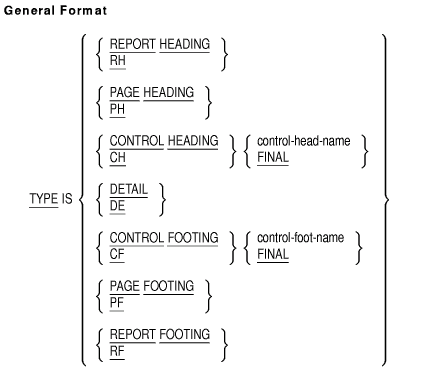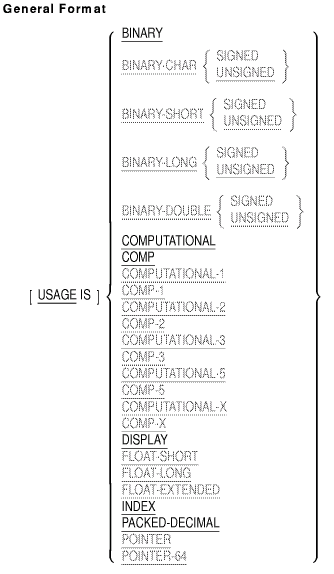| Previous | Contents | Index |
The SYNCHRONIZED clause specifies elementary item alignment on word boundary offsets relative to a record's beginning. These offsets are related to the size and usage of the item being stored.

| Data Type | Boundary |
|---|---|
| COMP (1 to 4 digits) | 2-byte |
| COMP (5 to 9 digits) | 4-byte |
| COMP (10 to 18 digits) | 8-byte |
| COMP (19 to 31 digits) | 16-byte |
| COMP-1 | 4-byte |
| COMP-2 | 8-byte |
| INDEX | 4-byte |
| POINTER | 4-byte (OpenVMS and Windows NT only) |
| POINTER | 8-byte (Tru64 UNIX only) |
Section 5.2.3, Additional Alignment Rules for Record Allocation
The TYPE clause identifies the report group type and indicates when the Report Writer Control System (RWCS) is to process it.

control-head-name
names a control-name in the CONTROL clause.control-foot-name
names a control-name in the CONTROL clause.
The UNDERLINE clause specifies that each character of the field is underlined when it is displayed on the screen.

The UNDERLINE clause may be specified only for elementary screen items.
5.3.52 USAGE
The USAGE clause specifies the internal format of a data item or screen item.

The default USAGE for a data item is DISPLAY. Therefore, you do not need to specify the USAGE clause for display numeric, alphabetic, and alphanumeric data items. |
| PICTURE Clause |
USAGE Clause | SIGN Clause | Allocated Storage in Bytes |
Standard Data Type |
|---|---|---|---|---|
|
PIC S9(n)
[n <= 31] |
DISPLAY | n | Right (trailing) overpunch | |
|
PIC S9(n)
[n <= 31] |
DISPLAY | TRAILING | n | Right (trailing) overpunch |
|
PIC S9(n)
[n <= 31] |
DISPLAY | LEADING | n | Left (leading) overpunch |
|
PIC S9(n)
[n <= 31] |
DISPLAY |
TRAILING
SEPARATE |
n+1 | Right (trailing) separate |
|
PIC S9(n)
[n <= 31] |
DISPLAY |
LEADING
SEPARATE |
n+1 | Left (leading) separate |
|
PIC 9(n)
[n <= 31] |
DISPLAY | n | Unsigned numeric | |
|
PIC 9(n)
[n <= 4] |
COMP
COMP-5 COMP-X |
2 | Word integer 1 | |
|
PIC 9(n)
[5 <= n <= 9] |
COMP
COMP-5 COMP-X |
4 | Longword integer 1 | |
|
PIC 9(n)
[10 <= n <= 18] |
COMP
COMP-5 COMP-X |
8 | Quadword integer 1 | |
|
PIC 9(n)
[19 <= n <= 31] |
COMP
COMP-5 COMP-X |
16 | Octaword integer 1 | |
|
PIC S9(n)
[n <= 4] |
COMP
COMP-5 COMP-X |
2 | Word integer | |
|
PIC S9(n)
[5 <= n <= 9] |
COMP
COMP-5 COMP-X |
4 | Longword integer | |
|
PIC S9(n)
[10 <= n <= 18] |
COMP
COMP-5 COMP-X |
8 | Quadword integer | |
|
PIC S9(n)
[19 <= n <= 31] |
COMP
COMP-5 COMP-X |
16 | Octaword integer | |
|
PIC X(n)
[n <= 2] |
COMP-5
COMP-X |
2 | Word integer 1 | |
|
PIC X(n)
[3 <= n <= 4] |
COMP-5
COMP-X |
4 | Longword integer 1 | |
|
PIC X(n)
[5 <= n <= 8] |
COMP-5
COMP-X |
8 | Quadword integer 1 | |
| Not applicable | INDEX | 4 | Longword integer | |
| Not applicable | POINTER | 4 | Longword integer (OpenVMS and Windows NT) | |
| POINTER | 8 | Quadword integer (Tru64 UNIX) | ||
| POINTER-64 | 8 | Quadword integer (OpenVMS) | ||
| Not applicable | BINARY-CHAR UNSIGNED | 2 | Word integer 1 | |
| Not applicable | BINARY-SHORT UNSIGNED | 2 | Word integer 1 | |
| Not applicable | BINARY-LONG UNSIGNED | 4 | Longword integer 1 | |
| Not applicable | BINARY-DOUBLE UNSIGNED | 8 | Quadword integer 1 | |
| Not applicable |
BINARY-CHAR SIGNED
BINARY-CHAR |
2 | Word integer | |
| Not applicable |
BINARY-SHORT SIGNED
BINARY-SHORT |
2 | Word integer | |
| Not applicable |
BINARY-LONG SIGNED
BINARY-LONG |
4 | Longword integer | |
| Not applicable |
BINARY-DOUBLE SIGNED
BINARY-DOUBLE |
8 | Quadword integer | |
| Not applicable | COMP-1 | 4 |
F_floating
S_format 2 |
|
| Not applicable | COMP-2 | 8 |
D_floating
G_floating T_format 2 |
|
|
PIC 9(n)
[n <= 31] |
COMP-3 |
(n+1)/2
rounded up |
Packed decimal 1 | |
|
PIC S9(n)
[n <= 31] |
COMP-3 |
(n+1)/2
rounded up |
Packed decimal | |
|
PIC X(n)
[n <= 65,535] |
DISPLAY | n |
ASCII text |
|
|
PIC A(n)
[n <= 65,535] |
DISPLAY | n |
ASCII text |
|
| PICTURE Clause |
USAGE Clause | SIGN Clause | Allocated Storage in Bytes |
Standard Data Type |
|---|---|---|---|---|
|
PIC S9(n)V9(s)
[(n+s) <= 31] |
DISPLAY | n+s |
Right (trailing)
overpunch |
|
|
PIC S9(n)V9(s)
[(n+s) <= 31] |
DISPLAY | TRAILING | n+s |
Right (trailing)
overpunch |
|
PIC S9(n)V9(s)
[(n+s) <= 31] |
DISPLAY | LEADING | n+s |
Left (leading)
overpunch |
|
PIC S9(n)V9(s)
[(n+s) <= 31] |
DISPLAY |
TRAILING
SEPARATE |
n+s+1 |
Right (trailing)
separate |
|
PIC S9(n)V9(s)
[(n+s) <= 31] |
DISPLAY |
LEADING
SEPARATE |
n+s+1 |
Left (leading)
separate |
|
PIC 9(n)V9(s)
[(n+s) <= 31] |
DISPLAY | n+s | Unsigned numeric | |
|
PIC 9(n)V9(s)
[(n+s) <= 4] |
COMP | 2 | Word integer 1 | |
|
PIC 9(n)V9(s)
[5 <= (n+s) <= 9] |
COMP | 4 | Longword integer 1 | |
|
PIC 9(n)V9(s)
[10 <= (n+s) <= 18] |
COMP | 8 | Quadword integer 1 | |
|
PIC 9(n)V9(s)
[19<= (n+s) <= 31] |
COMP | 16 | Octaword integer 1 | |
|
PIC S9(n)V9(s)
[(n+s) <= 4] |
COMP | 2 | Word integer | |
|
PIC S9(n)V9(s)
[5 <= (n+s) <= 9] |
COMP | 4 | Longword integer | |
|
PIC S9(n)V9(s)
[10 <= (n+s) <= 18] |
COMP | 8 | Quadword integer | |
|
PIC S9(n)V9(s)
[19 <= (n+s) <= 31] |
COMP | 16 | Octaword integer | |
|
PIC 9(n)V9(s)
[(n+s) <= 31] |
COMP-3 |
(n+s+1)/2
rounded up |
Packed decimal 1 | |
|
PIC S9(n)V9(s)
[(n+s) <= 31] |
COMP-3 |
(n+s+1)/2
rounded up |
Packed decimal | |
| Previous | Next | Contents | Index |